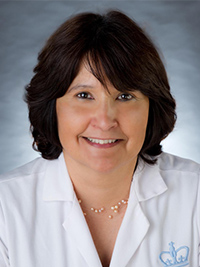Spinal muscular atrophy (SMA) is an autosomal recessive neuromuscular disorder that is characterized by atrophy and weakness of the skeletal muscles of the limbs and trunk and of the bulbar and respiratory muscles. In December 2016, nusinersen was approved by the U.S. Food and Drug Administration to treat children and adults with SMA type 1, 2, or 3 — the most common forms of the disease — thereby becoming the first approved therapy targeting the underlying cause of SMA.
Columbia faculty in child neurology served as investigators in pivotal studies of nusinersen, an antisense oligonucleotide shown to increase the levels of the survival motor neuron, a protein essential for motor neuron and muscle health, and the production of which is impaired in individuals with SMA due to mutations in the SMN1 gene. Another gene, SMN2, which has a slight difference in its DNA sequence, results in alternative splicing and limits the amount of working survival motor neuron it produces by 10 to 15 percent.
Alternative splicing is a natural process that allows for a single gene to give rise to many different proteins, adding or removing certain key ingredients. In this case, pieces of genetic information – exons – can change the resulting messenger RNA (mRNA) and final protein. In SMN2, this splicing event results in the exclusion of exon 7 from most of its mRNA molecules, leading to the generation of a shorter, less stable, and poorly working survival motor neuron protein. The number of SMN2 gene copies a patient has helps to determine disease severity, as a higher number is associated with the development of milder forms of SMA. Nusinersen binds to SMN2’s mRNA molecule and corrects its splicing. By preventing the removal of exon 7 from the resulting mRNA molecule, the therapy has the potential to restore the production of functional spinal motor neuron.
CHERISH Trial Shows Clinically Meaningful Response

Dr. Claudia Chiriboga
Columbia faculty along with investigators from three other sites participated in the initial, first-in-human phase 1/2 trials with nusinersen, with Columbia dosing the first ever patient with nusinersen in December 2011. These early studies in children with SMA type 2 and 3 raised no safety concerns and demonstrated a significant clinical meaningful motor response after nine months of treatment (Chiriboga et al, 2016). Following these investigations, the CHERISH trial, a phase 3 randomized study, was launched at 24 sites to evaluate nusinersen’s safety and effectiveness in children ages 2 to 12 with SMA types 2 and 3, who were able to sit, but not walk, independently.
NewYork-Presbyterian Morgan Stanley Children’s Hospital served as one of the study sites led by Claudia A. Chiriboga, MD, a child neurologist and Professor of Neurology and Pediatrics at Columbia and a member of Columbia’s Motor Neuron Center.
In the CHERISH trial, 126 children with spinal muscular atrophy were randomly assigned to undergo intrathecal administration of nusinersen at a dose of 12 mg or a sham procedure (control group) on days 1, 29, 85, and 274. The primary end point was changes in motor function measured at 15 months by the Hammersmith Functional Motor Scale-Expanded (HFMSE) score. Secondary end points included the percentage of children with a clinically meaningful increase from baseline in the HFMSE score (≥3 points), an outcome that indicates improvement in at least two motor skills.
The CHERISH Study Group found that nusinersen had the capability of producing meaningful changes in the clinical course of spinal muscular atrophy.
Among children with later-onset SMA, significant improvement in motor function was observed with nusinersen treatment as compared to the sham procedure. Trial participants and their caregivers indicated that stabilization of their current state would meet their therapeutic expectations and represent a clinically meaningful response.
In fact, the CHERISH investigators found that nusinersen had the capability of producing meaningful changes in the clinical course of SMA. The study’s findings, published in The New England Journal of Medicine in February 2018, showed:
- 57 percent of the children in the nusinersen group as compared with 26 percent in the control group had an increase in the HFMSE score from baseline to month 15 of at least 3 points
- The overall incidence of adverse events was similar in the nusinersen group and the control group (93 percent and 100 percent, respectively)
- The greatest improvements in the HFMSE score over the 15-month period were seen in younger children and in those who received treatment soon after symptom onset
The positive findings of the CHERISH trial led to its early termination, and all eligible children were transferred to an open-label extension trial – SHINE – to receive nusinersen over the long term. SHINE’s interim findings, released in May 2020 with up to 6.5 years of treatment for some patients, showed sustained benefits – from motor skill gains to disease stabilization – across a broad range of patients with spinal muscular atrophy ranging from toddlers to young adults.



